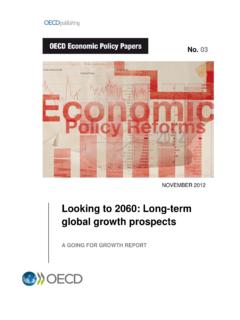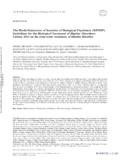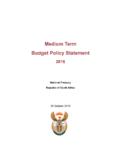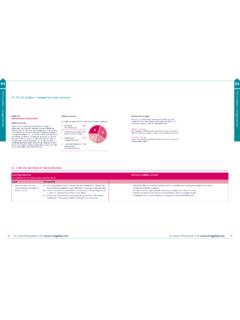Transcription of MEDIUM AND LONG-TERM SCENARIOS FOR GLOBAL …
1 OECD Economic Outlook,Volume 2012/1 OECD 2012191 Chapter 4 MEDIUM AND LONG-TERM SCENARIOS FOR GLOBAL growth AND IMBALANCES4. MEDIUM AND LONG-TERM SCENARIOS FOR GLOBAL growth AND IMBALANCESOECD ECONOMIC OUTLOOK, VOLUME 2012/1 OECD 2012 PRELIMINARY VERSION192 Introduction and summaryThis chapter considerslong-term prospects andrisks for the world economyMany countries face a long period of adjustment to erase the legaciesof the crisis, particularly high unemployment, excess capacity and largefiscal imbalances. Further ahead, demographic changes, including ageing,and fundamental forces of economic convergence will bring aboutmassive shifts in the composition of GLOBAL GDP. To illustrate the natureand scale of some of the policy challenges posed by these developments,this chapter describes MEDIUM and LONG-TERM SCENARIOS for OECD andnon-OECD G20 countries using a new modelling framework to extend theshort-term projections described in Chapters 1 to 3.
2 This frameworkfocuses on the interaction between technological progress, demographicchange, fiscal adjustment, current account imbalances and structuralpolicies. The SCENARIOS suggest that gradual but ambitious fiscalconsolidation and structural reforms could bring about substantial gainsin growth as well as reducing a range of risks, particularly by reducinglarge fiscal and current account key findings are:The main conclusions are:The next 40 years willsee major changes in therelative size of of the present non-OECD economies will continue to outpacethat of the present OECD countries, driven primarily by catch-up inmulti-factor productivity, but the difference will likely narrowsubstantially over coming decades. From over 7% per year on averageover the last decade, non-OECD growth may decline to around 5% inthe 2020s and to about half that by the 2040s.
3 Until 2020, China willhave the highest growth rate among major countries, but could be thensurpassed by both India and Indonesia. Fast growth in China and Indiawill take their combined GDP, measured at 2005 purchasing powerparities (PPPs), from less than half of the total output of the major sevenOECD economies in 2010 to exceeding it by around 2025. China s GDP isprojected to surpass that of the United States in but large gaps in livingstandards will persistin 2050lLarge GDP per capita differences will persist despite more rapid growthin poorer countries; for example, by 2050 GDP per capita in China andRussia will be about half of that of the leading countries, while in Brazilit will be about 40% and in India and Indonesia it will be about one-quarter. Among OECD countries, the most rapid catch-up in income percapita will likely occur in initially lower-income countries (Mexico,Turkey, Chile and Eastern European countries) while the dispersion inincome per capita among initially high-income countries will changeonly MEDIUM AND LONG-TERM SCENARIOS FOR GLOBAL growth AND IMBALANCESOECD ECONOMIC OUTLOOK, VOLUME 2012/1 OECD 2012 PRELIMINARY VERSION193 Fiscal and current accountimbalances are expected toworsenlIn the absence of ambitious policy changes, in particular ifgovernments just undertake sufficient measures to stabilise publicdebt, worsening and re-emerging imbalances could undermine growthprospects.
4 Firstly, as the current cycle unwinds, the scale of globalcurrent account imbalances may increase to pre-crisis peaks by thela te 2020s. In addition, in many OECD countries governmentindebtedness will exceed thresholds at which there is evidence ofadverse effects on interest rates, growth and the ability to stabilise needs tostabilise debt aresubstantial for manycountrieslFiscal consolidation requirements are substantial in many countries,particularly in the two largest. For Japan, stabilising the debt-to-GDPratio would eventually require a total improvement in the underlyingprimary balance of 13 percentage points of GDP from the 2011 position,with little progress expected over the next two For the UnitedStates, the total required fiscal consolidation to stabilise debt is about6 percentage points of GDP, of which about 2 percentage points ise x p e c t e d t o b e a ch i eve d by 2 0 1 3.
5 O t h e r c o u n t r i e s f o r w h i chconsolidation requirements are large include the euro area countriesthat have been under financial market pressure: Ireland, Greece,Portugal and Spain. To stabilise debt they require between 4 and7 percentage points of GDP improvement in the underlying primarybalance from the 2011 position on average until 2030, but most of thisadjustment is expected to be completed within the next two OECD countries requiring more than 4 percentage points of GDPof consolidation from 2011 include Poland, Slovak Republic, Sloveniaand United Kingdom. In addition, for a typical OECD country, additionaloffsets of 3 to 4% of GDP will have to be found over the coming 20 yearsto meet spending pressures due to increasing pension and health this basis there are largedifferences in the adequacyof current official planslThe United States and Japan also stand out because there is, as yet, alack of any detailed official MEDIUM -term fiscal plan that would besufficient to stabilise debt.
6 Japan has a MEDIUM -term plan, but it is notsufficiently ambitious. In the United States, there are a number of fiscalplans, but political disagreement makes the extent, pace andinstruments of future consolidation very uncertain. Very substantialfront-loaded consolidation is planned in those euro area countries Greece, Ireland and Portugal that requested assistance from theEuropean Union and the IMF. For these countries, and for most other1. For both Japan and the United States, the consolidation requirements reportedhere are higher than the average consolidation reported in Table , because aprotracted period of adjustment implies the total increase in the underlyingprimary balance by the end-year (2030 for the United States and 2040 for Japan)is significantly larger than the average increase over the period from 2011 to theend-year.
7 For other countries, where the requirement is smaller and/or much ofthe adjustment is expected by 2013, the difference between the average andend-year measure is typically MEDIUM AND LONG-TERM SCENARIOS FOR GLOBAL growth AND IMBALANCESOECD ECONOMIC OUTLOOK, VOLUME 2012/1 OECD 2012 PRELIMINARY VERSION194countries where consolidation needs are most severe, official MEDIUM -term consolidation plans exceed the requirements to stabilise debt, sotheir implementation would put the debt ratio on a downward reduce debt levels rapidlywould require much greaterconsolidationlConsolidation requirements would be more demanding if the aim wereto lower debt-to-GDP ratios to 60%, which for most countries could beachieved before 2030. For the OECD area as a whole, fiscal tighteningequivalent to a 6 percentage points of GDP increase in the underlyingprimary balance from the 2011 position would be required on averageuntil 2030, although this calculation is dominated by the requirementsof the two largest OECD economies.
8 Among OECD economies for whichdebt exceeds 100% of GDP, lowering the debt ratio to 60% by 2030requires 2-3 percentage points of GDP more consolidation than to onlystabilise debt. Japan is an exception, however, as it would require muchmore consolidation and even then there would be little prospect ofreaching a debt ration of 60% within the next two fiscalconsolidation would helpreduce GLOBAL imbalancesand riskslBecause consolidation needs are higher in current account deficitcountries, more ambitious LONG-TERM fiscal consolidation among OECD countries would help relieve GLOBAL current account government indebtedness to below thresholds where theyrisk affecting interest rates and lowering trend growth would alsocreate fiscal space for dealing with future shocks, as well as reducevulnerability to any future decline in GLOBAL saving.
9 Whether due toageing or other reforms couldboost growth and reduceimbalanceslA combination of ambitious fiscal consolidation efforts and deepstructural reforms can both raise long -run living standards and reducethe risks of major disruptions to growth by mitigating globalimbalances, raising aggregate OECD GDP in 2050 by 7% and non-OECDGDP by 13%, with much larger effects in countries where policy lagsmost behind best new modelling framework based on conditional convergenceScenarios are underpinnedby a new modellingframeworkLong-term growth projections are needed to facilitate the analysis ofmacroeconomic issues related to fiscal and international imbalances anddemographic shifts, which develop gradually over long time horizons, aswell as the effects of structural reforms on trend growth over the long there is no single theory of economic growth , there is wide supportfor a view in which each country converges to its own steady-statetrajectory of GDP per capita determined by the interface between globaltechnological development and country-specific structural conditionsand policies (so-called conditional convergence).
10 The SCENARIOS presentedin this chapter are underpinned by a new model which is used to extendthe short-term projections presented in Chapters 1 to3 by about 40 yearswithin a conditional convergence economic growth framework (Box ).4. MEDIUM AND LONG-TERM SCENARIOS FOR GLOBAL growth AND IMBALANCESOECD ECONOMIC OUTLOOK, VOLUME 2012/1 OECD 2012 PRELIMINARY VERSION195 Box new modelling framework for LONG-TERM economic projectionsThe new model is designed to extend the short-term projections over a horizon of about 40 years. It is areplacement for the OECD s MEDIUM -Term Baseline (MTB) model (Beffy et al., 2006) which was also used toextend the short-term projections, but over a shorter horizon. The country coverage has also broadened toinclude all OECD countries as well as current non-OECD G20 countries (Argentina, Brazil, China, India,Indonesia, the Russian Federation, Saudi Arabia and South Africa), equivalent to about 90% of world GDPin 2010 at market exchange rates.
















